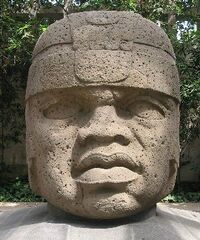Difference between revisions of "Rock-head statue"
PanchamBro (talk | contribs) m (Text replacement - "{{Main\|Item:(.*?) \(Fake\)" to "{{See also|Item:$1 (Fake)") |
PanchamBro (talk | contribs) m (PanchamBro moved page Rock-Head Statue to Rock-head statue over redirect: Per new changes to capitalization policy in Nookipedia:Manual of Style, moving page to match captialization of in-game name) |
(No difference)
| |
Revision as of 19:36, November 26, 2022
| ||||||
| Real-world counterpart | ||||||
|---|---|---|---|---|---|---|
| Olmec colossal heads | ||||||
| Year | c. 1000 BC | |||||
| Artist | Unknown | |||||
| Main appearances | ||||||
|
| ||||||
Name in other languages
いしあたまなちょうこく
石头颅雕塑 Sculpture déterminée Cabeza colosal Testa di roccia Твердолобая статуя
돌 머리의 조각 石頭顱雕塑 Sculpture déterminée Cabeza colosal Dickkopfskulptur Koppige standbeeld | ||||||
The Rock-Head Statue is a statue in Animal Crossing: New Horizons introduced in the 1.2.0 April Free Update. It is based on the Olmec colossal heads.
Art details
In New Horizons
| Museum description | Giant stone head thought to be from the ancient Mesoamerican Olmec civilization. The larger ones can reach three meters in height. Scholars think they only crafted heads, no bodies. |
|---|---|
| Buy price | |
| Sell price | |
| Obtain from | |
| Authenticity | In the forgery, the statue's lips are slightly curled into a smile. If the lips are more neutral, it is genuine. |
| Furniture size |
- ↑ Cannot be sold if it is a forgery.
Real-world information
The Olmec colossal heads are a series of traditional basalt sculptures carved by the Olmecs, the earliest known Mesoamerican civilization to have existed in human history, having occupied what is now Veracruz and Tabasco, Mexico, between 1500 BC to 400 BC. The colossal heads, often around the size of an adult human, are believed to represent rulers who were respected by and seen as powerful in Olmec tradition. While first discovered by José María Melgar y Serrano in 1862, the heads would still remain poorly-documented and obscure before the 1862 discovery was re-excavated by Matthew Stirling in 1938, after which they would skyrocket in popularity among the archaeological world and instigate further investigations into the Olmecs. Today, they stand in the public eye as the most iconic relic of Olmec civilization.
